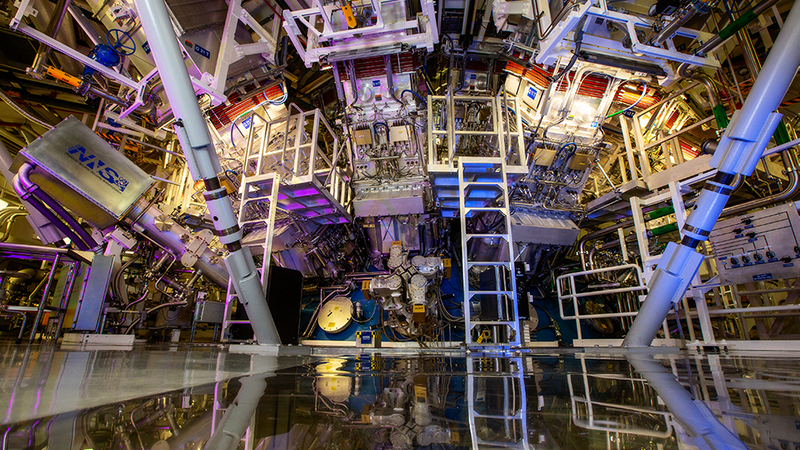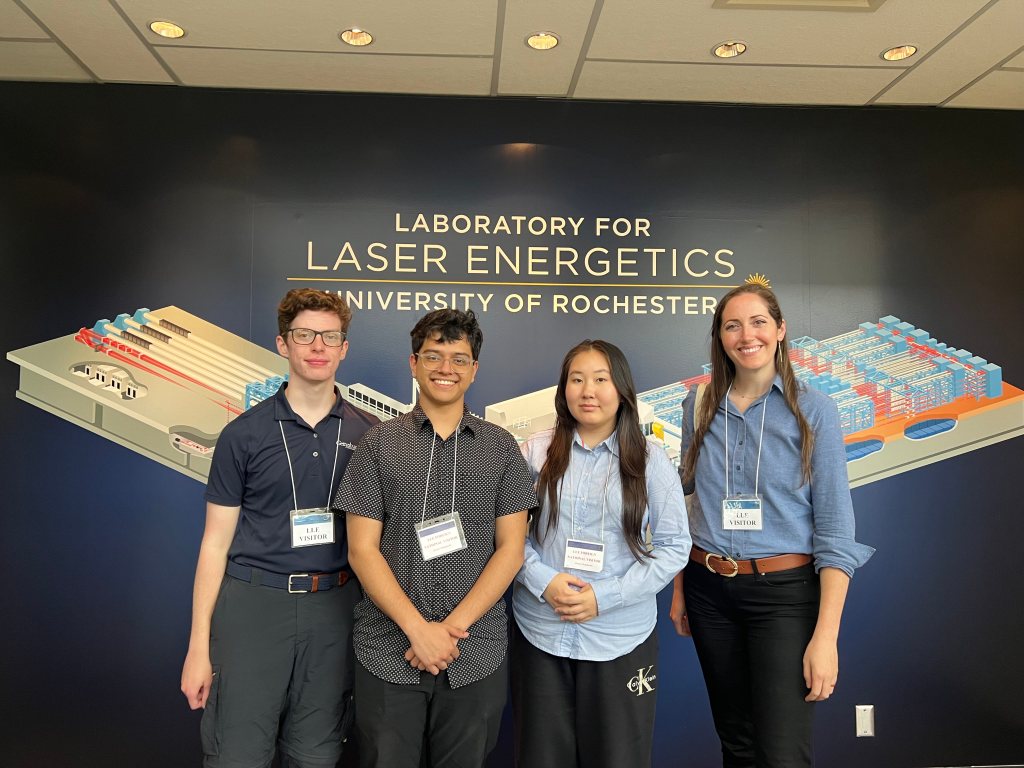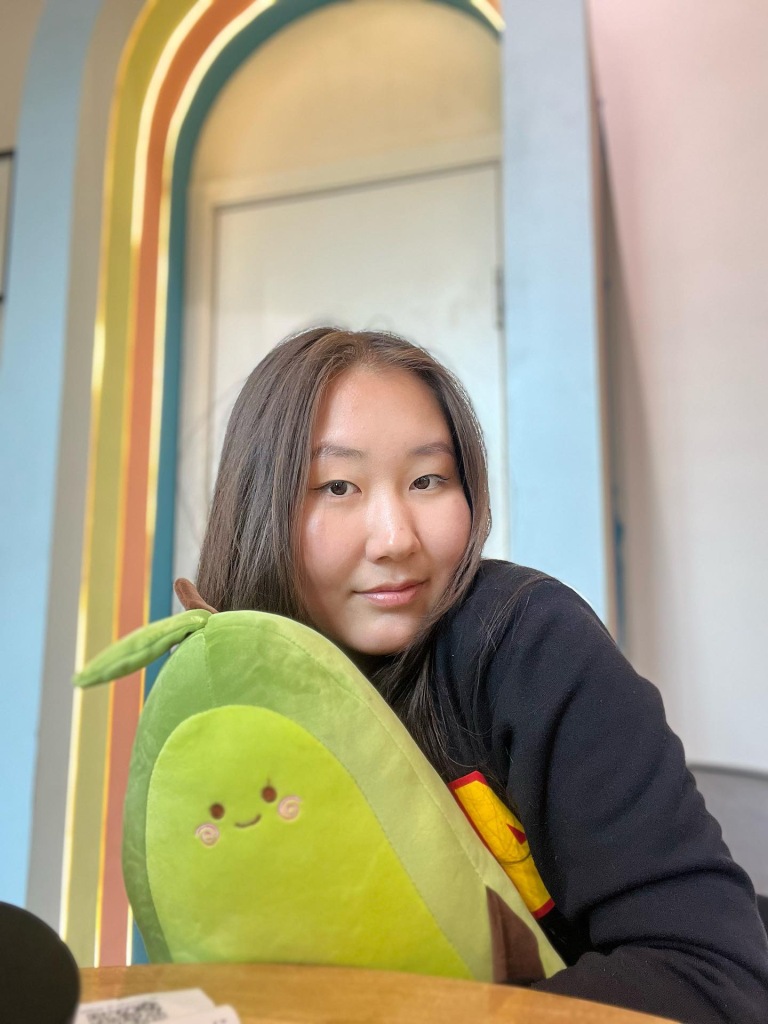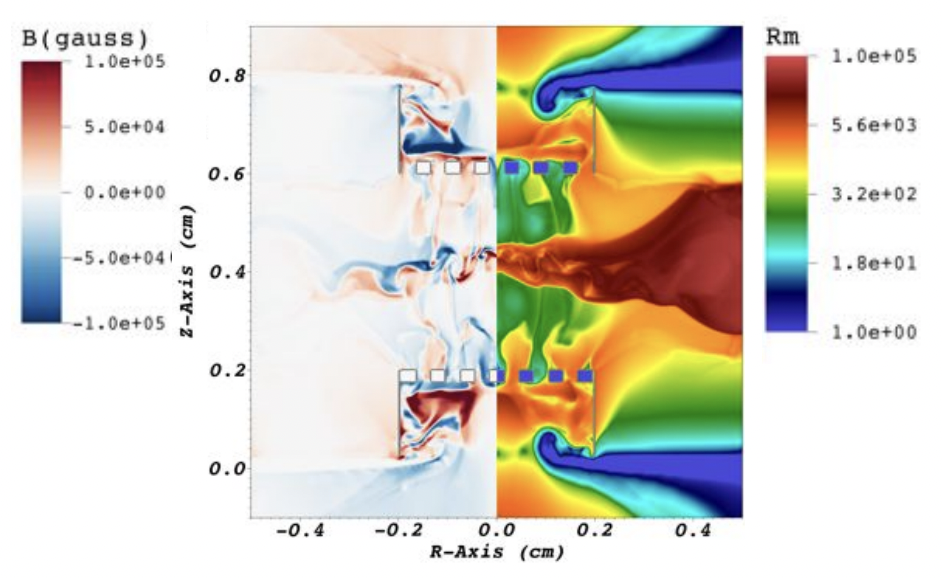Fifty years ago, if scientists wanted to understand the dynamics of phenomena in the universe (e.g., supernova explosions), they would have to point their telescopes in the sky and wait around for something to happen. This could take hundreds, thousands, or even millions of years.
We can’t wait around that long!
However….., we can now create tiny supernovas in the lab using powerful lasers. These lasers can create hot, fast plasmas that mimic the conditions of supernovas, galaxy clusters, and beyond. Supernovas that are parsecs in length and develop over hundreds of years (in space) can be scaled down to the size of a baseball and develop within fractions of a second (in the lab).
Why would we create tiny supernovas? Sure, they’re pretty cool, but there’s some world-leading research actually being done with them. Our research question is: What are the origins of the magnetic fields in the universe?
Sooo… why are magnetic fields important, you ask?? To our knowledge, magnetic fields did not exist at the on-set of the Big Bang but instead were created years later during the formation of large-scale structures such as galaxy clusters, filaments, and voids. Furthermore, magnetic fields are like the invisible glue that helps keep objects in the universe together and play a vital role in the formation of compact objects such as stars and galaxies.
This summer, we explored turbulent dynamo theory—the holy grail of laboratory astrophysics—a condition where magnetic fields begin to dominate the dynamics of a plasma. Only one laser in the world can produce this condition, the National Ignition Facility, and our group has laser time there!
NIF – National Ignition Facility
(maybe you’ve seen this laser in the recent Star Trek film…)
Our current understanding is that magnetic fields in our universe developed over 3 stages:
1. Small fields were seeded by, for instance, misaligned density and temperature gradients (Biermann Battery mechanism).
2. These small seed fields were then amplified by turbulent motions (e.g., a supernova hitting a cloud bank) much like ripples on a pond become chaotic when encountering rocks and plants.
3. Lastly, the fields continue to amplify until they reach a turbulent dynamo, where the magnetic energy becomes comparable with the kinetic energy of the plasma.
To test this understanding, we need to do laser experiments! Before using NIF, we need to test our theory on a “smaller” laser facility. Let’s head off to New York to use the second biggest laser in the USA…no big deal…
Our Trip To Omega Laboratory for Laser Energetics
At the beginning of summer, we had the incredible opportunity to visit the Omega Laser Facility at the University of Rochester, one of the largest laser labs in the world, and witness a laser shot experiment. It was a thrilling experience, where we toured the facility and met our professor’s amazing colleagues who led the experiment, each doing their magic for the success of the shot day.
In preparation for this major experiment, our professor trained us on various plasma diagnostic techniques. We learned about Thomson scattering, Bdot probes, GXD analysis, and many more. This training was not only educational but also eye-opening, giving us a taste of the real-world applications of the theoretical knowledge we had been learning throughout our school years.
The Omega Laser Facility itself was exhilarating. Walking into the lab, we were struck by the sheer size and sophistication of the setup. When on tour, we were able to see the massive laser systems and intricate diagnostic equipment that filled the spacious rooms. The atmosphere was filled with innovation and precision, reflecting the dedication and expertise of the scientists working there. It was a vivid reminder of the incredible advancements in plasma physics and the potential for future discoveries.
On the day of the laser shots, the four of us, along with Professor Meinecke’s colleagues, gathered at Omega early in the morning to start the experiment. We began with a briefing where everyone—I mean “everyone” such as technicians, mechanics, electricians, physicists, and many other specialists—filled the room. The atmosphere was tense (probably because we undergraduates were nervous at such a major place filled almost entirely with laser experts), but amazing. Seeing such collaboration and great minds working together was inspiring.
The most nerve wracking but exciting thing was the countdown of every laser shot itself.
10,9,8 ….. (Time for the shot…)
7,6,5….. (What if it fails?)
4,3,2 ….. (Let’s hope we don’t hear anything… because if we hear something, it means something is broken)
1……. (Silence)… the whole room is silent.
“The shot was successful”…. I believe with every countdown, we are closer to innovation and discovery.

The visit to Omega LLE was more than just a field trip; it was a window into the fascinating world of physics and the dedicated professionals who bring it to life. Seeing these experts in action, applying complex techniques, and working with cutting-edge technology was both inspiring and motivating. This experience reaffirmed our passion for the field and provided a glimpse of the exciting career paths that lie ahead in the realm of scientific research.
Now…. Let’s meet the members of the MagDen!
Our Professor…. drum roll…. Jena Meinecke!!!
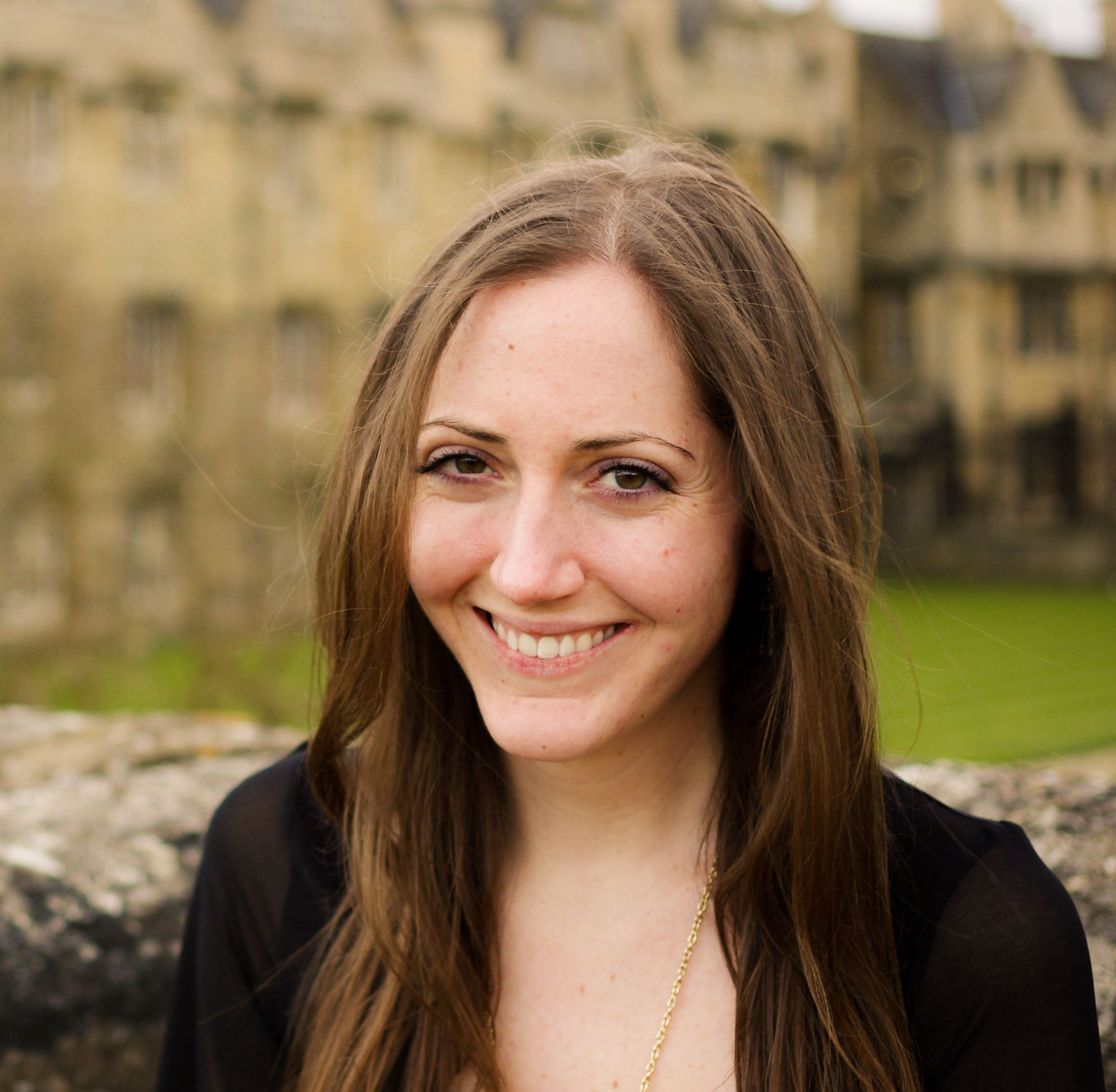
Let us introduce our AMAZING Professor Jena Meinecke! She conducts experiments using the largest lasers in the world to understand the origins of magnetic fields in the universe!!! Oxford graduate, new mother, rock climber, DDR master, and enthusiast of the Zelda series, she brings a wealth of experience and passion to her work.
Filled with smiles and care, she always comes to the office thinking about how to best prepare us for the world of physics research. Also, we get to meet “Lil Professor Meinecke” (baby Lander) from time to time, adding even more joy to our learning experience.
Meet Darshan!
Hello, My name is Darshan, and I’m from Nepal. I’m one of the rising sophomores working under Professor Meinecke this summer. I am majoring in Physics and CS and hope to be a researcher one day. In terms of hobbies, I like reading and playing games with friends (who make life so much better). If possible, I’d also like to be a writer, though I don’t think I’m any good at the moment.
Currently, I am working with Professor Meinecke on a new Gated X-ray Detector (GXD) diagnostic, resulting in a publication. GXD simply takes a picture of the light emitted from a plasma to determine its temperature. This is the first completely passive temperature diagnostic used on such experiments, which can help physicists understand their plasma (e.g., a tiny supernova) without disturbing it. The GXD method is also easier to use, as you just aim and take a ‘picture’; no secondary lasers and measuring instruments are needed.
A bit of context: When creating a plasma, we want to know 3 big things: the density of the plasma, the temperature of the plasma, and the speed at which the plasma is moving. On a laser shot, we take two pictures with GXD, each with a different filter on it. By comparing the two filtered images, we can create a 2D temperature map of our plasma!
At the beginning of the summer, we went to LLE for a million dollar laser shot day. We toured the facility and spent an entire day working alongside researchers from all over the world. Though we obviously weren’t responsible for the laser shot itself, we observed everyone else in their natural habitat and learned how laser experiments are run (at the big leagues!!). Stressed and confused, as research should be. We worked with the Oxford and Rochester grad students to organize the data from the laser shots and run some preliminary analysis. My responsibility was to monitor the GXD diagnostic and determine the temperature of our plasmas. What this really meant was checking that the cameras weren’t oversaturated with light and soaking up every bit of knowledge I could from these impressive collaborators!
A sample of how a GXD picture looks like! Very cool!
Meet Iveel!
Hi! My name is Iveel, and I am a rising sophomore majoring in physics and computer science. At first, I was planning on minoring in physics since I already had a physics background. After taking classes here, I fell in love with physics all over again, thanks to my peers and the amazing physics professors. This summer, I feel incredibly blessed to have the chance to work under Professor Meinecke. She has opened doors and provided opportunities, showing me places to grow and learn, marking the true beginning of my journey in physics. Without X-Sig and this unforgettable summer, I would still feel like a ship adrift at sea, searching for direction.
Before the LLE experiment, we learned about various plasma diagnostics, laser facilities, and the relationship between plasma and magnetic fields to prepare ourselves for the Omega laser experiment. My fun and informative project was to design posters that summarized almost everything that would be hung outside our professor’s office. I am basically assuming the role of “master of all the material” at this point (diagnostics, lasers, theory, and simulations).
Also, I had the chance to learn from Professor Meinecke’s colleague, Professor Petros Tzeferacos, who is developing the Flash Code at the University of Rochester. This powerful code is employed in a number of applications, from astrophysics to fusion reactions and many things in between. I am hoping to continue studying Flash code and learning simulation while learning hands-on work in the lab.
Example 2D Flash Simulation of the Magnetic Field ∼ 8 MG and Rm >> 1.
Having the chance to work under Professor Meinecke has been a great eye opener and unforgettable experience. Currently, I am building my relationship with physics and computer science to determine where I should exist within them. I’m leaning towards research and computational physics, which means grad school is looking over my shoulder. Other than that, I am from Mongolia, and I am an amateur pianist, dancer and a veteran FPS player. I am a person of many things, but I can confidently say, I will always be in STEM.
Meet Ethan!
Hello! My name is Ethan, and I am one of the very fortunate rising sophomores working with Professor Meinecke this summer. Between the dual degree engineering program and Professor Meinecke’s eagerness to push us to our limits, I have had more opportunities during this internship than I could have ever imagined. This May, we had the privilege to travel to the University of Rochester’s Omega laser facility, where we were able to work alongside some of the most brilliant minds working with inertially confined fusion, and without X-Sig, such an opportunity would have never existed. My work here is focused on the lab itself. My recent work has been dedicated to revitalizing the lab, but I plan to work with Professor Meinecke to fabricate Bdot probes, which will allow us to measure the magnetic fields created by our plasmas. Outside of school, I like to play a few instruments, though not particularly well. I’m also an amateur woodworker, cinematographer, and 3D modeler, and I enjoy playing a variety of video games.
One of six Bdot probes constructed at Oxford University
Workplace Makeover: Welcome to the MagDen


To make our mark as the first members of the MagDen, we are leading renovations on the MagDen lab (just look at that before and after!) while also decorating the space outside Professor Meinecke’s office where we work most of the time. This space now reflects our shared experiences and the collaborative spirit that defined our time here. We hope this space will welcome future students who will have the opportunity to work with Professor Meinecke, fostering the same sense of passion and collaboration.


